Fuel Tank Problems
![]()
Fuel Tank Problems |
|
|
From "Construction Notes" Falco Builders Letter, December 1990 |
Over the years we've had occasional problems with the fuel tanks, and these problems came in several catagories which are not related to each other. The very first tanks were not properly leak-checked, and there were a number that were shipped with tiny pinhole leaks. The shop making the tanks thought you could just submerge the tank in water and look for bubbles, but that won't catch the really tiny pinholes. The only way to check for those is to pump air into the tank to a pressure of about 2 psi and then brush soapy water over the welds.
We also found that it was necessary to use filler rod on the seam welds. You would think that simply melting the flanges together would be sufficient, but it isn't.
With those identifiable problems fixed, I thought we had heard the last of problems with the fuel tanks, but three of the Falcos have developed leaks in the fuel tanks. Jim DeAngelo had a slight leak develop in his front tank, and he pulled it out and had it re-welded. Since then, he has had no problems. And a couple of years ago, Pawel Kwiecinski developed a slow leak in his front tank, had to pull the tank and re-weld it.
And then recently John Oliver developed a leak in his front tank. The leak was in the weld along the bottom front left face of the tank, just outboard of the support strap. John was concerned about this and asked me to conduct an engineering review of the design of the tank.
I agreed to do this, but didn't know how. I remembered talking to Herb Andersen at Pitts some years ago and hearing him mention something about slosh and vibration tests, so I gave him a call. As chief engineer at Christen Industries, I thought he might know something about aluminum fuel tanks.
Herb said that they have never had any problems with the tanks for the Pitts, Christen Eagle or Christen Husky, but that years ago when he was general manager at Mooney, they had a problem with the wing tanks in the wood-wing Mooneys.
With the Mooney, they were having very occasional problems with leaks in the field. Nothing serious, just an occasional airplane would develop a tiny leak in a weld. They decided to put the tanks through the slosh and vibration test.
This is a torture-test for tanks, and what you do is support the tank as it is mounted in the airplane, fill it two-thirds full with water, vibrate it at a frequency that's 90% of the maximum continuous rated power speed of the engine for a minimum displacement of 1/32" and then you rock the tank 15° each way, left wing down-right wing down, at a rate of 16 to 20 times a minute. In other words, you rock the tank to slosh the water around as you shake the tank to introduce a vibration into the water, and the tank must survive this for 25 hours.
Herb will never forget what happened. The same tanks that had given only occasional problems in the field failed the test in three minutes. It didn't just develop a little tiny leak-the entire end of the tank fell out, onto the floor. Herb said it was an astonishing thing to see. They ended up putting a couple of small aluminum angles on the tank ends to kill the vibration, and the tanks passed the test and have never given problems again.
Herb said it made him a believer in the slosh and vibration test. He said if you get a tank to go 25 hours in this test, you'll never have a problem. He said that tank design was something that you couldn't engineer on paper. All you could do was design the tank as experience dictated and then test it. It was all cut-and-try to solve the problems you found.
I talked to Dave Thurston, who confirmed it. He said that tank design was a black art and that in his fifty years of aircraft design, he had never known anyone who got a tank design right the first time. You always had to test the tank and fix the problems you found.
John Oliver, who is an engineer, had already analyzed the problem and had zeroed in on the flat panels of the tank bottom, the loads imposed by the support straps on the welds, and on the weld design of the tanks. As the leak had occured just outboard of the support strap, he concluded that the loads imposed on the welds by the strap probably contributed to the failure. He came up with a way of strengthening that part of the tank by welding a round aluminum bar on the tank.
The tank was put back in the shop where the welds were ground off, the tank was rewelded, and the reinforcing rods were installed. In the meantime, I designed and built a testing fixture of Baltic birch plywood, a gearmotor, and a motor with an eccentric arm to generate the vibration.
We tested the tank, and the tank developed a leak after approximately 4 hours. During the test, the flat bottom of the tank was vibrating noticeably and this is what we all suspected would happen, because it's always the flat parts of tanks that give you the problem. When a flat panel vibrates, it fatigues the weld, and the weld will fail.
The other part of the tank that was vibrating noticeably was the right front face of the tank-right in front of the radio stack cutout. This only occured when the 'right wing' was down, but there was a noticeable increase in noise, and you could see and hear the panel vibrating. An architect friend who saw it said he thought the vibration was caused by the shorter distance between the forward face of the tank and the radio stack. The leak that developed was-as you might guess-directly below this area along the seam weld with the tank bottom.
There was also a barely audible musical sound to the tank. As it rocked to the right, you could hear an 'underwater', steel-band-like sound. There were three notes, in quick succession, and not unexpectedly there was a chordal tonic-dominant-tonic relationship between the rising-frequency notes.
We all want to see this problem corrected, but let's put this in perspective. If we hadn't done the test and had never discovered the problem, what we would probably have is an occasional problem with the tanks. Every year or two, a Falco tank would develop a problem and the tank would be removed and rewelded. It would be considered a maintenance problem-one of those things that the plane has a problem with.
Also when the failures occur, they are hairline fatigue failures in the welds, and they do not result in catastrophic failures. An engineer friend of mine said that at the company that he once worked they had seen a similar problem with a sprayer they made. It had a motor and a square-shaped tank, and all of the machines developed leaks in the tanks within twenty hours or so. There were about fifty of these machines, and the leaks developed like clockwork in all of the tanks. But in every case the failure was the same-just a little hairline fatigue failure in the weld that leaked fuel very slowly.
I want to develop a fix for the problem that is field-installable. The obvious task was to stiffen the flat bottom and also the right front of the tank. The right front of the tank proved to be a simple matter of welding on a U-channel of aluminum that would fit around the wooden support on frame No. 1, and we also did this on the left side as a matter of course.
To stiffen the bottom, we installed eight hat-section channels, and a tab of aluminum that wrapped around the seam weld and also the reinforcing rod, which was extended to the center of the tank. All of this is perhaps a bit of over-kill, but I want this problem solved. The methods were worked out in concert with our shop and presented to Dave Thurston, John Oliver and Stelio Frati for their comments.
With these changes made, we put the tank back in the slosh and vibration test. The changes that we made dramatically stiffened the bottom of the tank and none of the earlier pulsing of the bottom or right front could be observed. However, the tank developed a leak on the left front, along the vertical seam. This weld had not been ground off. There is a small flat area on the left and right side of the tank, and those areas were pulsing slightly. The pulsing did not have nearly as much displacement as the other two areas had before, but the panel was moving.
The vertical seam weld had not been ground off and rewelded between tests, so it's reasonable to consider that the failure occured after six hours of testing, although the tank must pass with a full 25 hours of testing.
As I write this, the tank is back in the shop for rewelding and for installing a brace on the tank ends. This is a difficult problem and one that takes much longer to solve than any of us would like. When we have the problem worked out, we will be in direct touch with all of you who have these tanks.
In the meantime, you should be aware of the problem, and you should inspect the tanks often for leaks along the welds with the tank bottom.
When we finish with the front fuel tank, we will put the aft tank through the same test. It has given us no problem so far, largely because it is well insulated and removed from the engine vibration. But with the large, flat bottom, it is probable that the tank will require modification to pass the slosh and vibration test.
Please bear with us while we work on this problem. We will have another report in the next builder letter and a complete report along with drawings and fixes will be available when the problem is solved.
|
From "Construction Notes" Falco Builders Letter, March 1991 |
We've made good progress on the fuel tank problem, although it's been slower than anyone would like. The front tank passes the 25-hour test with the braces installed as described in the last newsletter. Steve Wilkinson switched tanks with us and has the reinforced-and-tested tank in his plane.
There were two minor interference problems. One of the braces on the bottom of the tank rubbed his right brake master cylinder bracket. We're solving that in the future by moving the brace inboard by 10mm.
The second problem is that the end braces hit frame 3, and Steve had to bend them over slightly to get the tank to clear. Funny, I worked it all out that the braces would clear when installed, but never checked to see if you could get it in!
My original intention was to test the aft tank to see if it would fail and then fix what problems that we found. The aft tank seemed to be well designed, except for the flat bottom. The forward and aft ends are nicely bulged, and the top is a continuously curving surface. But the bottom has large flat areas and is a third again as deep, front-to-back, as the forward tank.
I spent some time looking at the tank, feeling the stiffness of the tank bottom, and I arrived at the conclusion that it was senseless to test it. The tank would certainly fail the test, and it would just add time and expense to the process. You would think that the shallow-vee of the bottom would add some stiffness to the tank bottom, and it does to some extent. But the area around the sump is very soft because the beading stops.
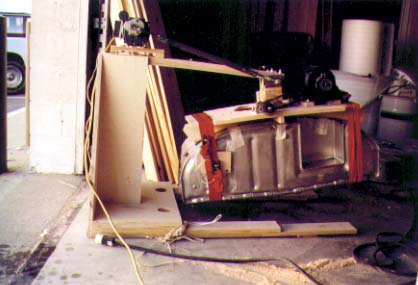
The slosh and vibration test rig with the forward fuel tank. A
motor over the
tank swings an eccentric weight on a shaft to provide the vibration,
while a
gearmotor with an eccentric arm connected to a pushrod provides
the slighing.
Having watched the front tank perform in the test rig, I came to the conclusion that the stiffening methods we used on the tank were gross overkill and added needlessly to the expense. In particular, the business of welding a 3/8"Ø rod along the bottom of the tank and then wrapping plates up fron the ends of the hat-sections and around the rod seemed silly. There's no question that it strengthened the tank, but I became convinced that the problem was one of vibration in flat panels-and nothing else.
So with the aft tank, we installed a hat-section on each side at B.L. 75. With the beading in place and with the tank stiffened in the center by the hat-sections, I figured the tank might pass the test. These hat-section braces were 'open' at the end; that is, they were just cut off square, and there's no end cap. You can peek down in the end of the brace and look clear through.
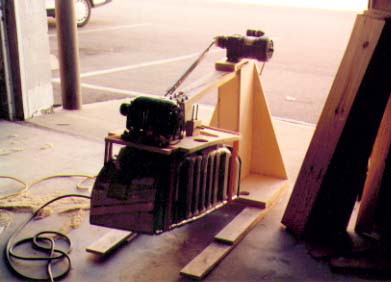
After the brace was installed, I put the tank in the test rig and fired it up. It was immediately apparent that the tank was not going to pass the test, because the flat bottom of the tank was pulsing substantially-and having seen this sort of behavior in the front tank, it was obvious that the tank would never go 25 hours.
So we stopped the test with only a few minutes of running and installed another hat-section brace on each side at B.L. 275. This time when we put the tank back in the test rig, it seemed equally obvious that the tank would pass the 25-hour test. No panel of the tank was vibrating abnormally, and the tank rode through the test without any noticeable noise.
At about 18 hours into the test, a small pin-hole leak developed at the end of one of the B.L. 75 braces. We continued to let the test run to 25 hours to see if the crack would propagate, and it did not. I concluded-and John Oliver and our tank fabricator agreed-that the leak was a fabrication problem and not a design problem.
When the hat-section brace was welded to the tank, a clamp was used to hold the brace in place and you could see at the weld that the seam along the bottom was 'dented' upward from this clamping pressure. We concluded that this created an internal stress and that is was also possible that the weld was stressed by removing the clamp prior to the metal fully cooling after welding. I also noticed that a similar crack was developing at the other end of the tank, on the same brace, but this had not developed into a leak.
As this was on the other end of the same brace-with the seam similarly dented-and on no other braces, we felt this was confirmation that the problem was one of fabrication and not design. Also, when a panel vibrates, it would normally fail the weld at the midpoint between braces, and not at the end of the brace. We all concluded that the aft tank had passed the test.
Since the aft tank passed with four open-ended hat-section braces on the bottom, I concluded that it was likely that the same four-brace solution would work on the front tank. So we had the braces installed on the front tank and put it back in the test rig.
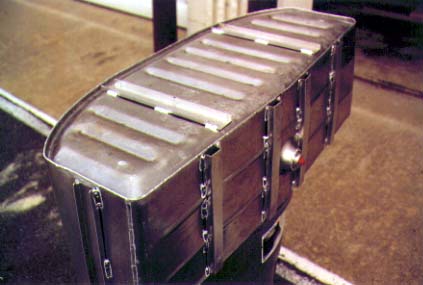
The front tank in this configuration survived 9 hours of the
test and then failed. It will require 8 braces at the bottom.
I failed to mention that the aft tank test was interrupted when the pillow block bearings used for the vibrator shaft failed from fatigue, and it took several days to get replacements. You can be assured that this test is tough on equipment when a pillow block bearing fails.
The test of the front tank seemed to be a pro-forma test -- certainly it would pass -- and like the aft tank, it rode through the early part of the test without any strange noises or vibrations. But then at about 8-1/2 hours into the test, you could start to hear harmonic, 'under-water' sounds, and the tank developed a leak at 9 hours. This was a full-fledged, un-zip-the-weld, fatigue failure in the weld.
It took a while for me to understand the cause of the problem, but what was happening was that as the tank rocked left-wing low, the bottom of the tank on the right side started to pulse strongly. This was right under the radio box, and it was obvious that the same short-period amplification that had earlier afflicted the front face of this tank was now getting the bottom. Dave Thurston is right-this is a black art.
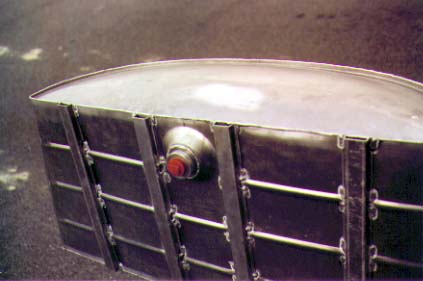
The aft tank passed the slosh and vibration test with
these four hat-section braces installed on the bottom.
As I write this, the front tank is back in the shop getting additional braces installed. John Oliver figures that three braces on each side would do the trick, but since we've already proved that four braces on each side will work with end caps, we're just going to go with four braces. Although the pulsing problem is only on the right side, we are putting the same number of braces on both sides.
I'm fairly confident that this will solve the problem and that we'll have the tank problem finally solved in a week or so. We will get upgrade kits made up and shipped out as soon as feasible. This will include drawings and a complete report on the tests performed and the repairs necessary.
By the way, I've found that a lot of you are under the impression that the sloshing is part of the torture for the tank. Actually, the way the test works is that the vibration does all the damage, and the sloshing just makes sure you have a good distribution of the frequency possibilities. Obviously, you are not going to fly around with a wing down 15° all day, but the genius of the test is that the sloshing with a two-thirds-full tank simulates the operation of the tank with various levels of fuel.
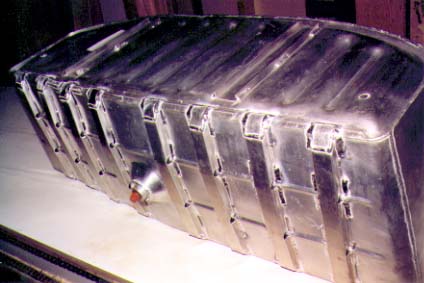
The final design of the front tank that passed the test.
|
|